Coles Retail: Market Trends, Future of Retail, and Business Operations
VerifiedAdded on 2023/06/04
|11
|2582
|343
Report
AI Summary
This report provides a comprehensive analysis of the future of the retail industry, with a specific focus on the business operations of Coles. It begins with an introduction that highlights the changing demands of customers and the impact of digital transformation on the retail sector. The report then delves into Coles' current business operations, including its online presence, employee base, and financial performance. It explores market trends shaping the future of retail, such as voice-driven shopping, augmented reality, and the Internet of Things, drawing on research from various academic sources. The application of these trends to Coles is then examined, considering the implementation of technologies like ERP and CRM. The report concludes with recommendations for Coles to adapt to the evolving retail landscape, emphasizing the importance of digital integration, AR technologies, and customer-centric strategies to maintain a competitive advantage in the market. The report also addresses the limitations of Coles in adapting to new technologies, customer support and promotional strategies.
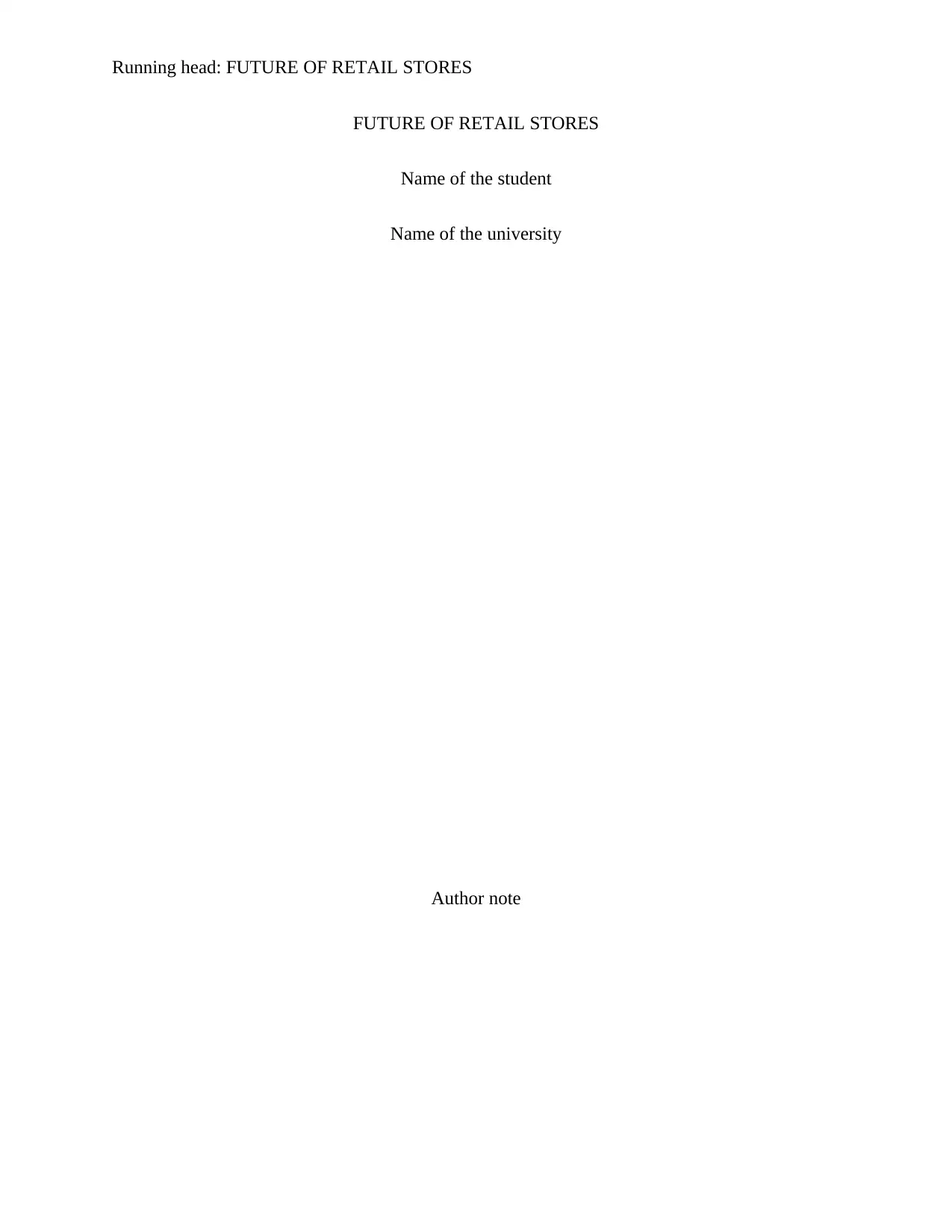
Running head: FUTURE OF RETAIL STORES
FUTURE OF RETAIL STORES
Name of the student
Name of the university
Author note
FUTURE OF RETAIL STORES
Name of the student
Name of the university
Author note
Paraphrase This Document
Need a fresh take? Get an instant paraphrase of this document with our AI Paraphraser
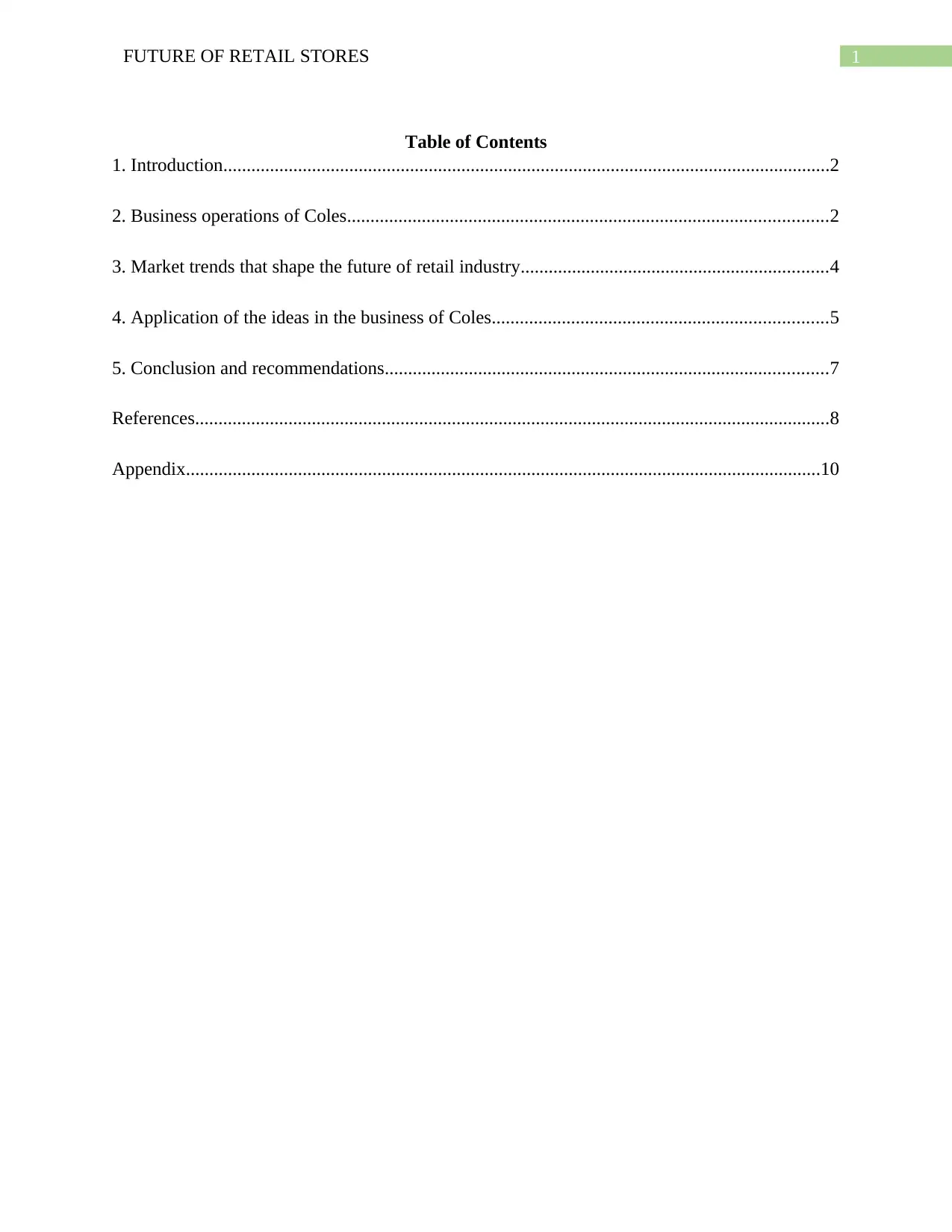
1FUTURE OF RETAIL STORES
Table of Contents
1. Introduction..................................................................................................................................2
2. Business operations of Coles.......................................................................................................2
3. Market trends that shape the future of retail industry..................................................................4
4. Application of the ideas in the business of Coles........................................................................5
5. Conclusion and recommendations...............................................................................................7
References........................................................................................................................................8
Appendix........................................................................................................................................10
Table of Contents
1. Introduction..................................................................................................................................2
2. Business operations of Coles.......................................................................................................2
3. Market trends that shape the future of retail industry..................................................................4
4. Application of the ideas in the business of Coles........................................................................5
5. Conclusion and recommendations...............................................................................................7
References........................................................................................................................................8
Appendix........................................................................................................................................10
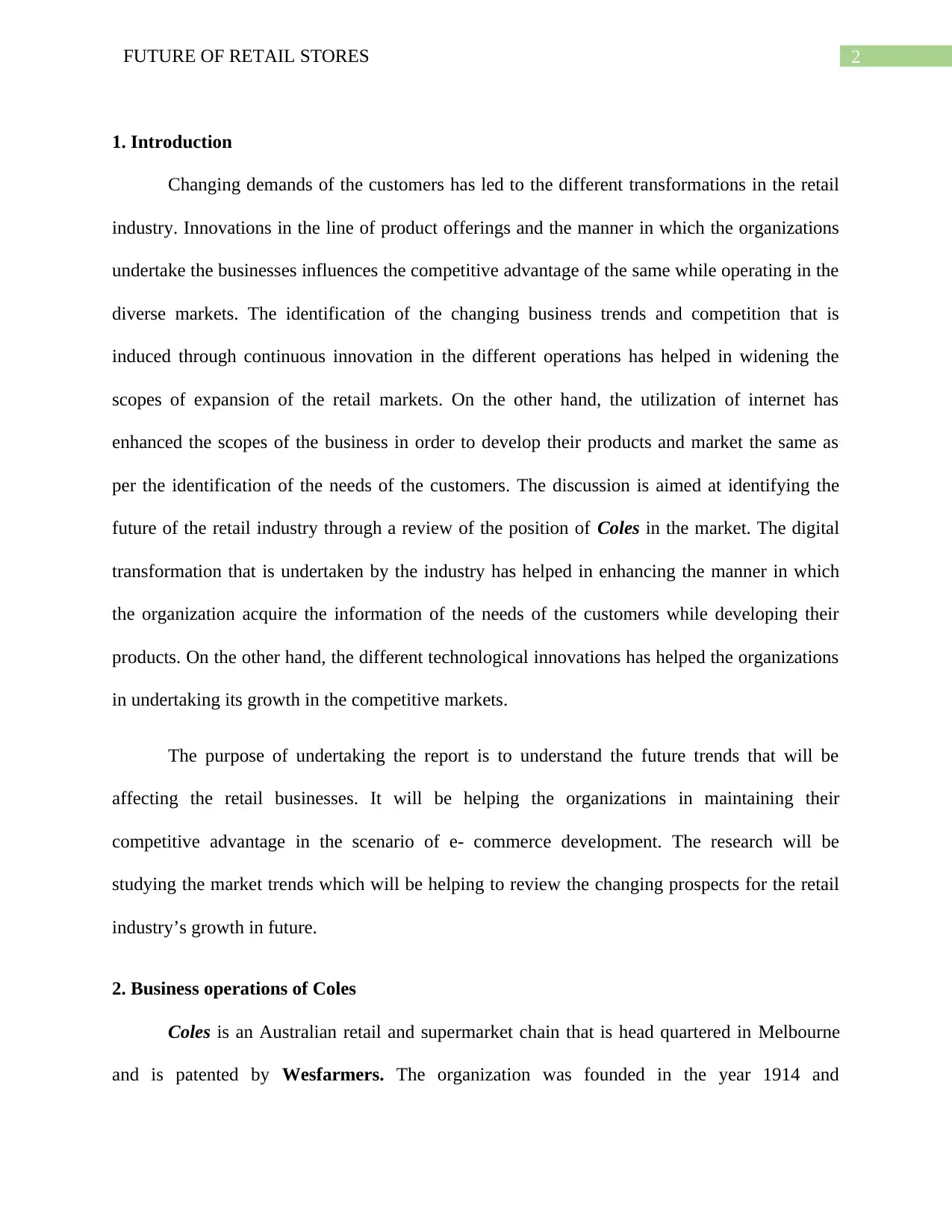
2FUTURE OF RETAIL STORES
1. Introduction
Changing demands of the customers has led to the different transformations in the retail
industry. Innovations in the line of product offerings and the manner in which the organizations
undertake the businesses influences the competitive advantage of the same while operating in the
diverse markets. The identification of the changing business trends and competition that is
induced through continuous innovation in the different operations has helped in widening the
scopes of expansion of the retail markets. On the other hand, the utilization of internet has
enhanced the scopes of the business in order to develop their products and market the same as
per the identification of the needs of the customers. The discussion is aimed at identifying the
future of the retail industry through a review of the position of Coles in the market. The digital
transformation that is undertaken by the industry has helped in enhancing the manner in which
the organization acquire the information of the needs of the customers while developing their
products. On the other hand, the different technological innovations has helped the organizations
in undertaking its growth in the competitive markets.
The purpose of undertaking the report is to understand the future trends that will be
affecting the retail businesses. It will be helping the organizations in maintaining their
competitive advantage in the scenario of e- commerce development. The research will be
studying the market trends which will be helping to review the changing prospects for the retail
industry’s growth in future.
2. Business operations of Coles
Coles is an Australian retail and supermarket chain that is head quartered in Melbourne
and is patented by Wesfarmers. The organization was founded in the year 1914 and
1. Introduction
Changing demands of the customers has led to the different transformations in the retail
industry. Innovations in the line of product offerings and the manner in which the organizations
undertake the businesses influences the competitive advantage of the same while operating in the
diverse markets. The identification of the changing business trends and competition that is
induced through continuous innovation in the different operations has helped in widening the
scopes of expansion of the retail markets. On the other hand, the utilization of internet has
enhanced the scopes of the business in order to develop their products and market the same as
per the identification of the needs of the customers. The discussion is aimed at identifying the
future of the retail industry through a review of the position of Coles in the market. The digital
transformation that is undertaken by the industry has helped in enhancing the manner in which
the organization acquire the information of the needs of the customers while developing their
products. On the other hand, the different technological innovations has helped the organizations
in undertaking its growth in the competitive markets.
The purpose of undertaking the report is to understand the future trends that will be
affecting the retail businesses. It will be helping the organizations in maintaining their
competitive advantage in the scenario of e- commerce development. The research will be
studying the market trends which will be helping to review the changing prospects for the retail
industry’s growth in future.
2. Business operations of Coles
Coles is an Australian retail and supermarket chain that is head quartered in Melbourne
and is patented by Wesfarmers. The organization was founded in the year 1914 and
⊘ This is a preview!⊘
Do you want full access?
Subscribe today to unlock all pages.

Trusted by 1+ million students worldwide
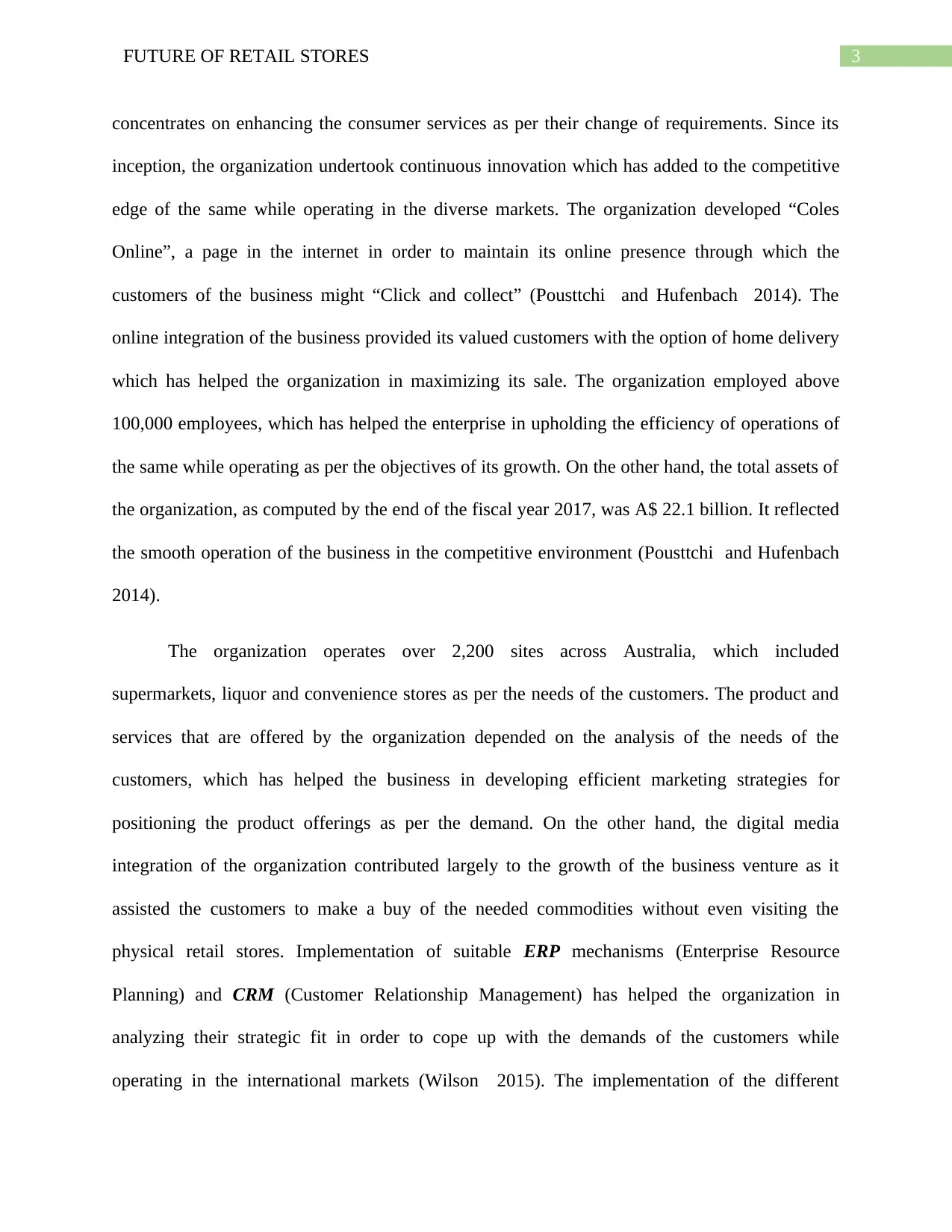
3FUTURE OF RETAIL STORES
concentrates on enhancing the consumer services as per their change of requirements. Since its
inception, the organization undertook continuous innovation which has added to the competitive
edge of the same while operating in the diverse markets. The organization developed “Coles
Online”, a page in the internet in order to maintain its online presence through which the
customers of the business might “Click and collect” (Pousttchi and Hufenbach 2014). The
online integration of the business provided its valued customers with the option of home delivery
which has helped the organization in maximizing its sale. The organization employed above
100,000 employees, which has helped the enterprise in upholding the efficiency of operations of
the same while operating as per the objectives of its growth. On the other hand, the total assets of
the organization, as computed by the end of the fiscal year 2017, was A$ 22.1 billion. It reflected
the smooth operation of the business in the competitive environment (Pousttchi and Hufenbach
2014).
The organization operates over 2,200 sites across Australia, which included
supermarkets, liquor and convenience stores as per the needs of the customers. The product and
services that are offered by the organization depended on the analysis of the needs of the
customers, which has helped the business in developing efficient marketing strategies for
positioning the product offerings as per the demand. On the other hand, the digital media
integration of the organization contributed largely to the growth of the business venture as it
assisted the customers to make a buy of the needed commodities without even visiting the
physical retail stores. Implementation of suitable ERP mechanisms (Enterprise Resource
Planning) and CRM (Customer Relationship Management) has helped the organization in
analyzing their strategic fit in order to cope up with the demands of the customers while
operating in the international markets (Wilson 2015). The implementation of the different
concentrates on enhancing the consumer services as per their change of requirements. Since its
inception, the organization undertook continuous innovation which has added to the competitive
edge of the same while operating in the diverse markets. The organization developed “Coles
Online”, a page in the internet in order to maintain its online presence through which the
customers of the business might “Click and collect” (Pousttchi and Hufenbach 2014). The
online integration of the business provided its valued customers with the option of home delivery
which has helped the organization in maximizing its sale. The organization employed above
100,000 employees, which has helped the enterprise in upholding the efficiency of operations of
the same while operating as per the objectives of its growth. On the other hand, the total assets of
the organization, as computed by the end of the fiscal year 2017, was A$ 22.1 billion. It reflected
the smooth operation of the business in the competitive environment (Pousttchi and Hufenbach
2014).
The organization operates over 2,200 sites across Australia, which included
supermarkets, liquor and convenience stores as per the needs of the customers. The product and
services that are offered by the organization depended on the analysis of the needs of the
customers, which has helped the business in developing efficient marketing strategies for
positioning the product offerings as per the demand. On the other hand, the digital media
integration of the organization contributed largely to the growth of the business venture as it
assisted the customers to make a buy of the needed commodities without even visiting the
physical retail stores. Implementation of suitable ERP mechanisms (Enterprise Resource
Planning) and CRM (Customer Relationship Management) has helped the organization in
analyzing their strategic fit in order to cope up with the demands of the customers while
operating in the international markets (Wilson 2015). The implementation of the different
Paraphrase This Document
Need a fresh take? Get an instant paraphrase of this document with our AI Paraphraser
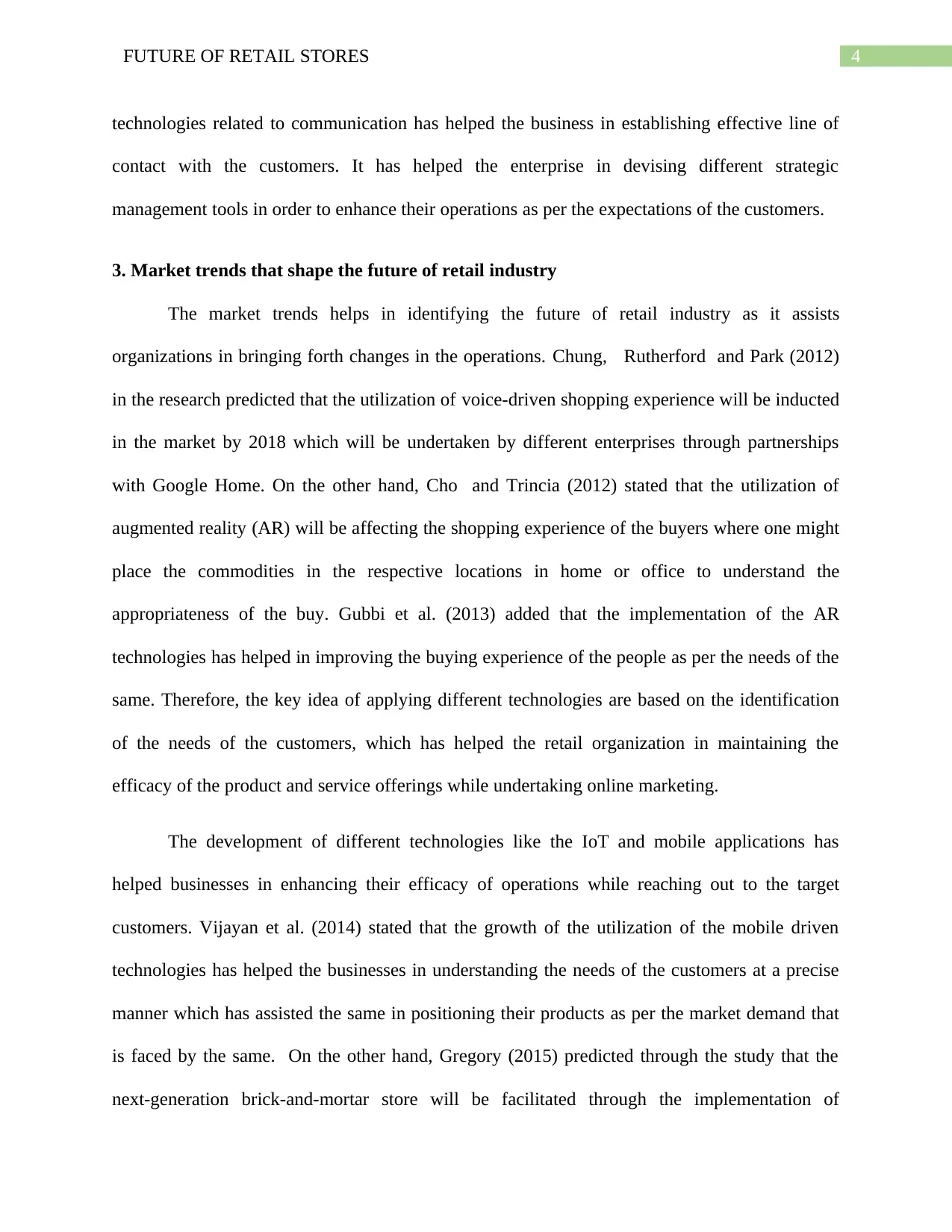
4FUTURE OF RETAIL STORES
technologies related to communication has helped the business in establishing effective line of
contact with the customers. It has helped the enterprise in devising different strategic
management tools in order to enhance their operations as per the expectations of the customers.
3. Market trends that shape the future of retail industry
The market trends helps in identifying the future of retail industry as it assists
organizations in bringing forth changes in the operations. Chung, Rutherford and Park (2012)
in the research predicted that the utilization of voice-driven shopping experience will be inducted
in the market by 2018 which will be undertaken by different enterprises through partnerships
with Google Home. On the other hand, Cho and Trincia (2012) stated that the utilization of
augmented reality (AR) will be affecting the shopping experience of the buyers where one might
place the commodities in the respective locations in home or office to understand the
appropriateness of the buy. Gubbi et al. (2013) added that the implementation of the AR
technologies has helped in improving the buying experience of the people as per the needs of the
same. Therefore, the key idea of applying different technologies are based on the identification
of the needs of the customers, which has helped the retail organization in maintaining the
efficacy of the product and service offerings while undertaking online marketing.
The development of different technologies like the IoT and mobile applications has
helped businesses in enhancing their efficacy of operations while reaching out to the target
customers. Vijayan et al. (2014) stated that the growth of the utilization of the mobile driven
technologies has helped the businesses in understanding the needs of the customers at a precise
manner which has assisted the same in positioning their products as per the market demand that
is faced by the same. On the other hand, Gregory (2015) predicted through the study that the
next-generation brick-and-mortar store will be facilitated through the implementation of
technologies related to communication has helped the business in establishing effective line of
contact with the customers. It has helped the enterprise in devising different strategic
management tools in order to enhance their operations as per the expectations of the customers.
3. Market trends that shape the future of retail industry
The market trends helps in identifying the future of retail industry as it assists
organizations in bringing forth changes in the operations. Chung, Rutherford and Park (2012)
in the research predicted that the utilization of voice-driven shopping experience will be inducted
in the market by 2018 which will be undertaken by different enterprises through partnerships
with Google Home. On the other hand, Cho and Trincia (2012) stated that the utilization of
augmented reality (AR) will be affecting the shopping experience of the buyers where one might
place the commodities in the respective locations in home or office to understand the
appropriateness of the buy. Gubbi et al. (2013) added that the implementation of the AR
technologies has helped in improving the buying experience of the people as per the needs of the
same. Therefore, the key idea of applying different technologies are based on the identification
of the needs of the customers, which has helped the retail organization in maintaining the
efficacy of the product and service offerings while undertaking online marketing.
The development of different technologies like the IoT and mobile applications has
helped businesses in enhancing their efficacy of operations while reaching out to the target
customers. Vijayan et al. (2014) stated that the growth of the utilization of the mobile driven
technologies has helped the businesses in understanding the needs of the customers at a precise
manner which has assisted the same in positioning their products as per the market demand that
is faced by the same. On the other hand, Gregory (2015) predicted through the study that the
next-generation brick-and-mortar store will be facilitated through the implementation of
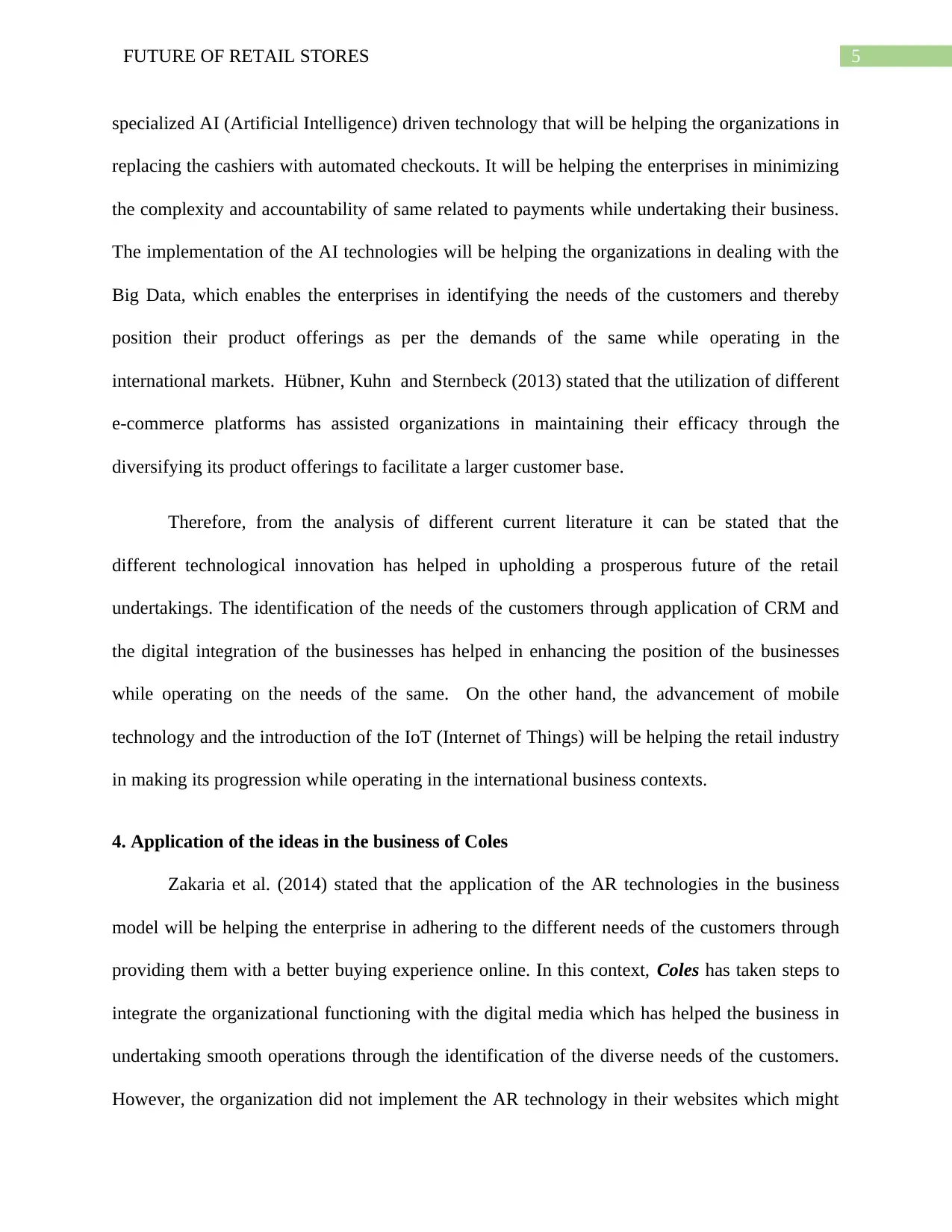
5FUTURE OF RETAIL STORES
specialized AI (Artificial Intelligence) driven technology that will be helping the organizations in
replacing the cashiers with automated checkouts. It will be helping the enterprises in minimizing
the complexity and accountability of same related to payments while undertaking their business.
The implementation of the AI technologies will be helping the organizations in dealing with the
Big Data, which enables the enterprises in identifying the needs of the customers and thereby
position their product offerings as per the demands of the same while operating in the
international markets. Hübner, Kuhn and Sternbeck (2013) stated that the utilization of different
e-commerce platforms has assisted organizations in maintaining their efficacy through the
diversifying its product offerings to facilitate a larger customer base.
Therefore, from the analysis of different current literature it can be stated that the
different technological innovation has helped in upholding a prosperous future of the retail
undertakings. The identification of the needs of the customers through application of CRM and
the digital integration of the businesses has helped in enhancing the position of the businesses
while operating on the needs of the same. On the other hand, the advancement of mobile
technology and the introduction of the IoT (Internet of Things) will be helping the retail industry
in making its progression while operating in the international business contexts.
4. Application of the ideas in the business of Coles
Zakaria et al. (2014) stated that the application of the AR technologies in the business
model will be helping the enterprise in adhering to the different needs of the customers through
providing them with a better buying experience online. In this context, Coles has taken steps to
integrate the organizational functioning with the digital media which has helped the business in
undertaking smooth operations through the identification of the diverse needs of the customers.
However, the organization did not implement the AR technology in their websites which might
specialized AI (Artificial Intelligence) driven technology that will be helping the organizations in
replacing the cashiers with automated checkouts. It will be helping the enterprises in minimizing
the complexity and accountability of same related to payments while undertaking their business.
The implementation of the AI technologies will be helping the organizations in dealing with the
Big Data, which enables the enterprises in identifying the needs of the customers and thereby
position their product offerings as per the demands of the same while operating in the
international markets. Hübner, Kuhn and Sternbeck (2013) stated that the utilization of different
e-commerce platforms has assisted organizations in maintaining their efficacy through the
diversifying its product offerings to facilitate a larger customer base.
Therefore, from the analysis of different current literature it can be stated that the
different technological innovation has helped in upholding a prosperous future of the retail
undertakings. The identification of the needs of the customers through application of CRM and
the digital integration of the businesses has helped in enhancing the position of the businesses
while operating on the needs of the same. On the other hand, the advancement of mobile
technology and the introduction of the IoT (Internet of Things) will be helping the retail industry
in making its progression while operating in the international business contexts.
4. Application of the ideas in the business of Coles
Zakaria et al. (2014) stated that the application of the AR technologies in the business
model will be helping the enterprise in adhering to the different needs of the customers through
providing them with a better buying experience online. In this context, Coles has taken steps to
integrate the organizational functioning with the digital media which has helped the business in
undertaking smooth operations through the identification of the diverse needs of the customers.
However, the organization did not implement the AR technology in their websites which might
⊘ This is a preview!⊘
Do you want full access?
Subscribe today to unlock all pages.

Trusted by 1+ million students worldwide
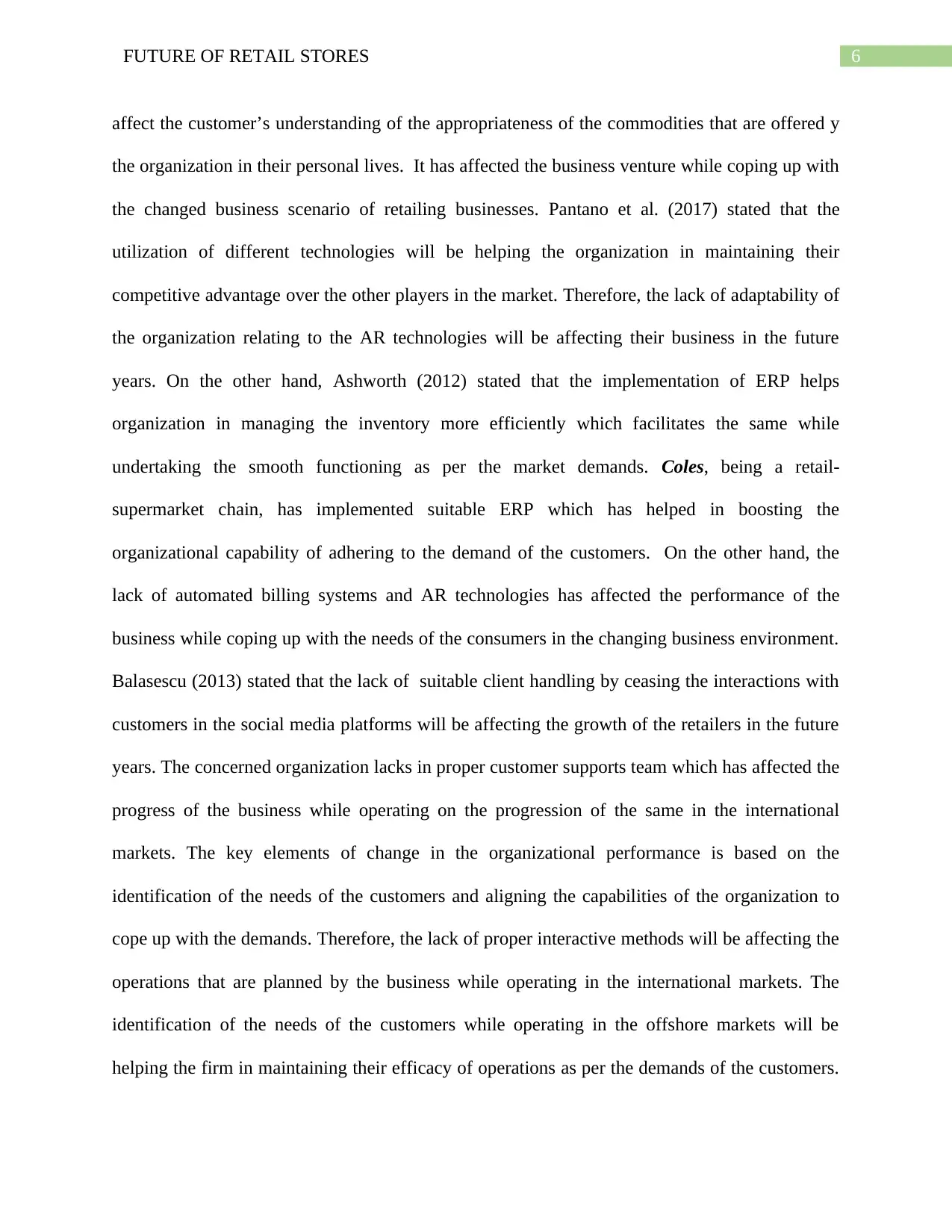
6FUTURE OF RETAIL STORES
affect the customer’s understanding of the appropriateness of the commodities that are offered y
the organization in their personal lives. It has affected the business venture while coping up with
the changed business scenario of retailing businesses. Pantano et al. (2017) stated that the
utilization of different technologies will be helping the organization in maintaining their
competitive advantage over the other players in the market. Therefore, the lack of adaptability of
the organization relating to the AR technologies will be affecting their business in the future
years. On the other hand, Ashworth (2012) stated that the implementation of ERP helps
organization in managing the inventory more efficiently which facilitates the same while
undertaking the smooth functioning as per the market demands. Coles, being a retail-
supermarket chain, has implemented suitable ERP which has helped in boosting the
organizational capability of adhering to the demand of the customers. On the other hand, the
lack of automated billing systems and AR technologies has affected the performance of the
business while coping up with the needs of the consumers in the changing business environment.
Balasescu (2013) stated that the lack of suitable client handling by ceasing the interactions with
customers in the social media platforms will be affecting the growth of the retailers in the future
years. The concerned organization lacks in proper customer supports team which has affected the
progress of the business while operating on the progression of the same in the international
markets. The key elements of change in the organizational performance is based on the
identification of the needs of the customers and aligning the capabilities of the organization to
cope up with the demands. Therefore, the lack of proper interactive methods will be affecting the
operations that are planned by the business while operating in the international markets. The
identification of the needs of the customers while operating in the offshore markets will be
helping the firm in maintaining their efficacy of operations as per the demands of the customers.
affect the customer’s understanding of the appropriateness of the commodities that are offered y
the organization in their personal lives. It has affected the business venture while coping up with
the changed business scenario of retailing businesses. Pantano et al. (2017) stated that the
utilization of different technologies will be helping the organization in maintaining their
competitive advantage over the other players in the market. Therefore, the lack of adaptability of
the organization relating to the AR technologies will be affecting their business in the future
years. On the other hand, Ashworth (2012) stated that the implementation of ERP helps
organization in managing the inventory more efficiently which facilitates the same while
undertaking the smooth functioning as per the market demands. Coles, being a retail-
supermarket chain, has implemented suitable ERP which has helped in boosting the
organizational capability of adhering to the demand of the customers. On the other hand, the
lack of automated billing systems and AR technologies has affected the performance of the
business while coping up with the needs of the consumers in the changing business environment.
Balasescu (2013) stated that the lack of suitable client handling by ceasing the interactions with
customers in the social media platforms will be affecting the growth of the retailers in the future
years. The concerned organization lacks in proper customer supports team which has affected the
progress of the business while operating on the progression of the same in the international
markets. The key elements of change in the organizational performance is based on the
identification of the needs of the customers and aligning the capabilities of the organization to
cope up with the demands. Therefore, the lack of proper interactive methods will be affecting the
operations that are planned by the business while operating in the international markets. The
identification of the needs of the customers while operating in the offshore markets will be
helping the firm in maintaining their efficacy of operations as per the demands of the customers.
Paraphrase This Document
Need a fresh take? Get an instant paraphrase of this document with our AI Paraphraser
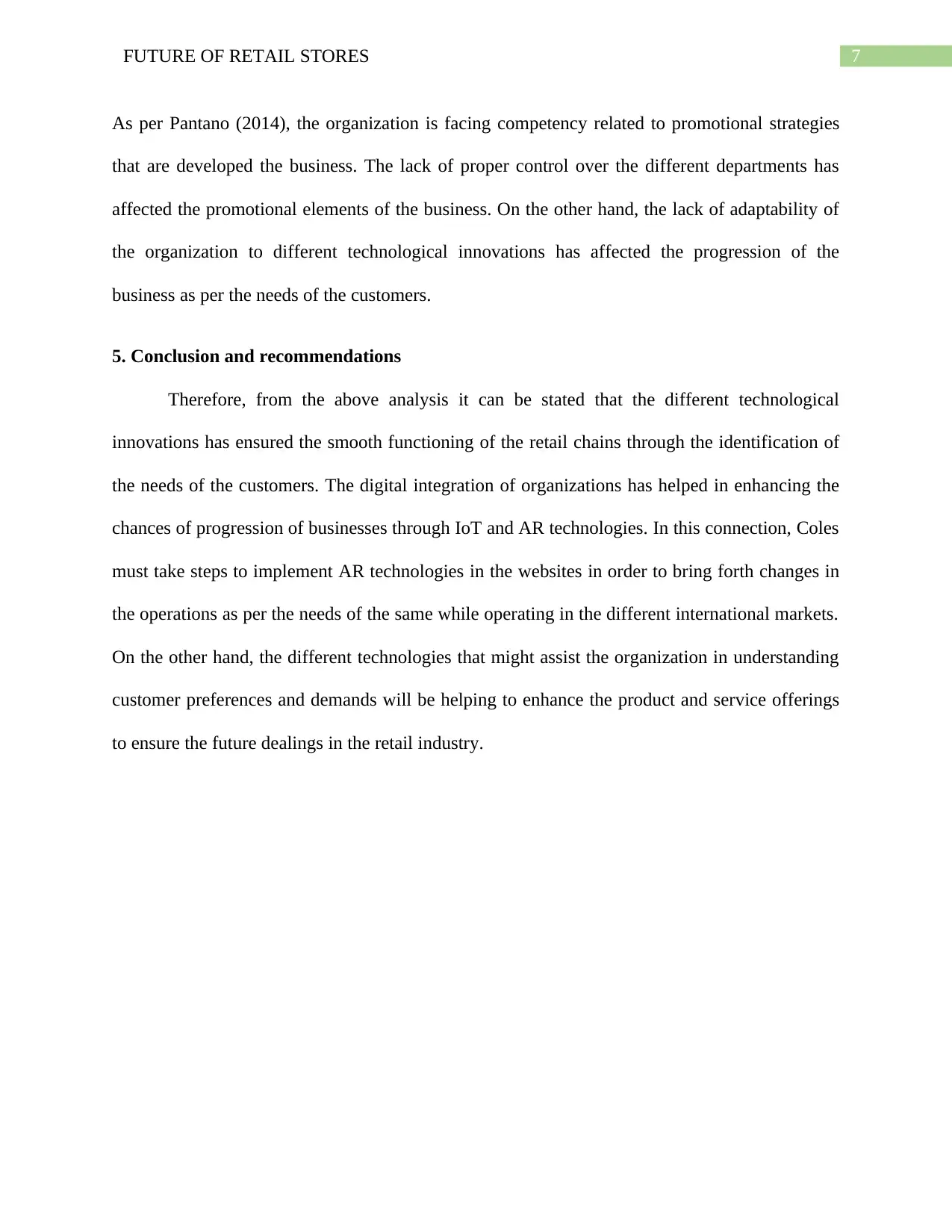
7FUTURE OF RETAIL STORES
As per Pantano (2014), the organization is facing competency related to promotional strategies
that are developed the business. The lack of proper control over the different departments has
affected the promotional elements of the business. On the other hand, the lack of adaptability of
the organization to different technological innovations has affected the progression of the
business as per the needs of the customers.
5. Conclusion and recommendations
Therefore, from the above analysis it can be stated that the different technological
innovations has ensured the smooth functioning of the retail chains through the identification of
the needs of the customers. The digital integration of organizations has helped in enhancing the
chances of progression of businesses through IoT and AR technologies. In this connection, Coles
must take steps to implement AR technologies in the websites in order to bring forth changes in
the operations as per the needs of the same while operating in the different international markets.
On the other hand, the different technologies that might assist the organization in understanding
customer preferences and demands will be helping to enhance the product and service offerings
to ensure the future dealings in the retail industry.
As per Pantano (2014), the organization is facing competency related to promotional strategies
that are developed the business. The lack of proper control over the different departments has
affected the promotional elements of the business. On the other hand, the lack of adaptability of
the organization to different technological innovations has affected the progression of the
business as per the needs of the customers.
5. Conclusion and recommendations
Therefore, from the above analysis it can be stated that the different technological
innovations has ensured the smooth functioning of the retail chains through the identification of
the needs of the customers. The digital integration of organizations has helped in enhancing the
chances of progression of businesses through IoT and AR technologies. In this connection, Coles
must take steps to implement AR technologies in the websites in order to bring forth changes in
the operations as per the needs of the same while operating in the different international markets.
On the other hand, the different technologies that might assist the organization in understanding
customer preferences and demands will be helping to enhance the product and service offerings
to ensure the future dealings in the retail industry.
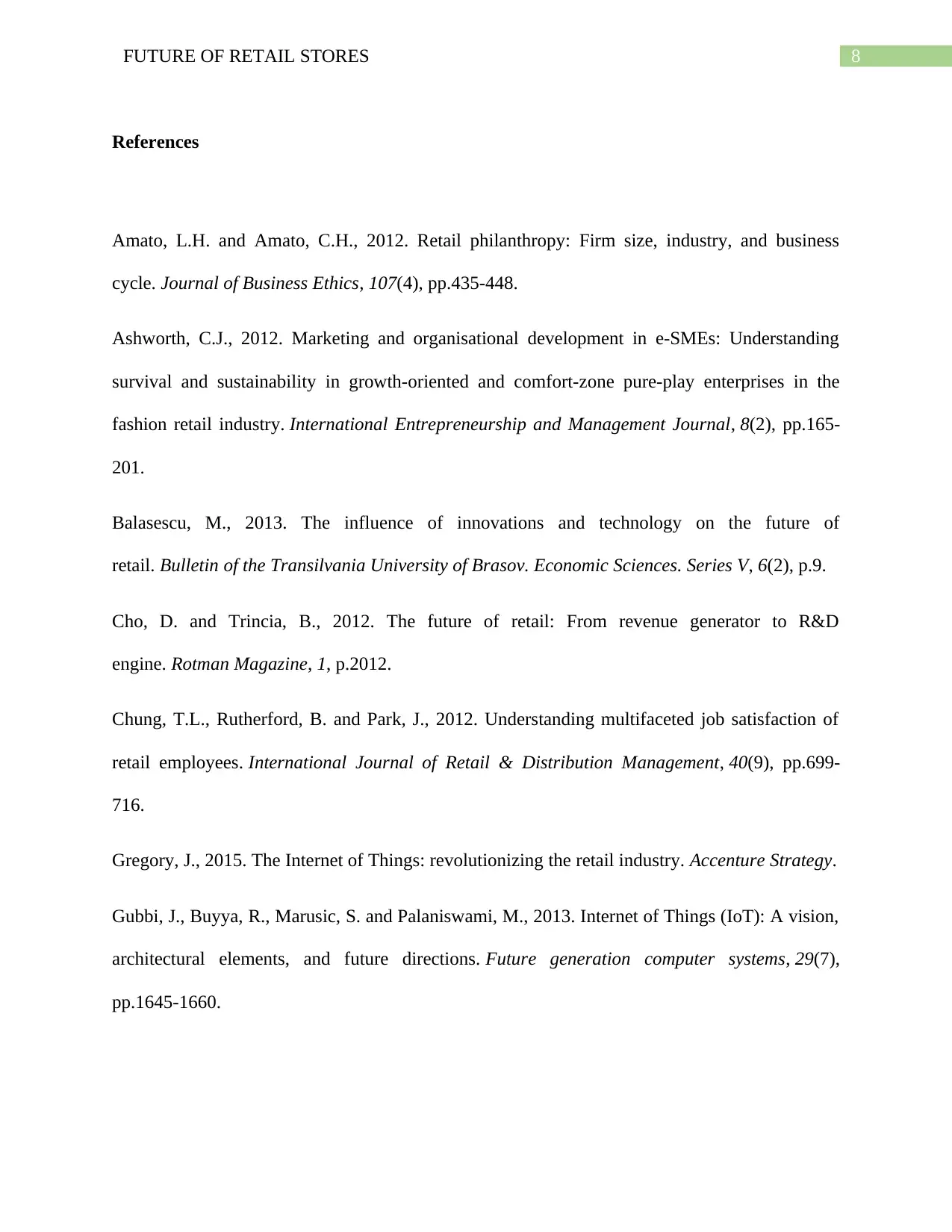
8FUTURE OF RETAIL STORES
References
Amato, L.H. and Amato, C.H., 2012. Retail philanthropy: Firm size, industry, and business
cycle. Journal of Business Ethics, 107(4), pp.435-448.
Ashworth, C.J., 2012. Marketing and organisational development in e-SMEs: Understanding
survival and sustainability in growth-oriented and comfort-zone pure-play enterprises in the
fashion retail industry. International Entrepreneurship and Management Journal, 8(2), pp.165-
201.
Balasescu, M., 2013. The influence of innovations and technology on the future of
retail. Bulletin of the Transilvania University of Brasov. Economic Sciences. Series V, 6(2), p.9.
Cho, D. and Trincia, B., 2012. The future of retail: From revenue generator to R&D
engine. Rotman Magazine, 1, p.2012.
Chung, T.L., Rutherford, B. and Park, J., 2012. Understanding multifaceted job satisfaction of
retail employees. International Journal of Retail & Distribution Management, 40(9), pp.699-
716.
Gregory, J., 2015. The Internet of Things: revolutionizing the retail industry. Accenture Strategy.
Gubbi, J., Buyya, R., Marusic, S. and Palaniswami, M., 2013. Internet of Things (IoT): A vision,
architectural elements, and future directions. Future generation computer systems, 29(7),
pp.1645-1660.
References
Amato, L.H. and Amato, C.H., 2012. Retail philanthropy: Firm size, industry, and business
cycle. Journal of Business Ethics, 107(4), pp.435-448.
Ashworth, C.J., 2012. Marketing and organisational development in e-SMEs: Understanding
survival and sustainability in growth-oriented and comfort-zone pure-play enterprises in the
fashion retail industry. International Entrepreneurship and Management Journal, 8(2), pp.165-
201.
Balasescu, M., 2013. The influence of innovations and technology on the future of
retail. Bulletin of the Transilvania University of Brasov. Economic Sciences. Series V, 6(2), p.9.
Cho, D. and Trincia, B., 2012. The future of retail: From revenue generator to R&D
engine. Rotman Magazine, 1, p.2012.
Chung, T.L., Rutherford, B. and Park, J., 2012. Understanding multifaceted job satisfaction of
retail employees. International Journal of Retail & Distribution Management, 40(9), pp.699-
716.
Gregory, J., 2015. The Internet of Things: revolutionizing the retail industry. Accenture Strategy.
Gubbi, J., Buyya, R., Marusic, S. and Palaniswami, M., 2013. Internet of Things (IoT): A vision,
architectural elements, and future directions. Future generation computer systems, 29(7),
pp.1645-1660.
⊘ This is a preview!⊘
Do you want full access?
Subscribe today to unlock all pages.

Trusted by 1+ million students worldwide
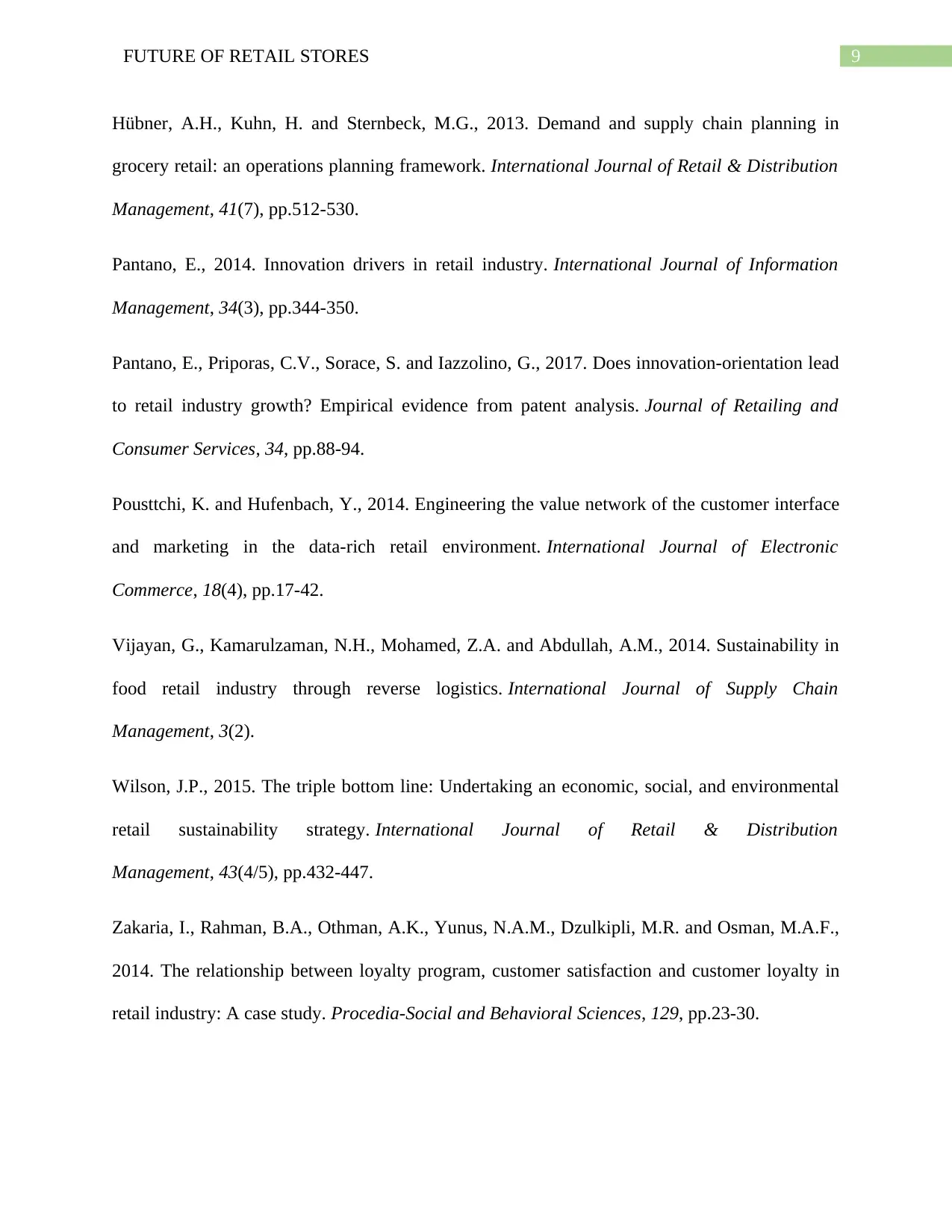
9FUTURE OF RETAIL STORES
Hübner, A.H., Kuhn, H. and Sternbeck, M.G., 2013. Demand and supply chain planning in
grocery retail: an operations planning framework. International Journal of Retail & Distribution
Management, 41(7), pp.512-530.
Pantano, E., 2014. Innovation drivers in retail industry. International Journal of Information
Management, 34(3), pp.344-350.
Pantano, E., Priporas, C.V., Sorace, S. and Iazzolino, G., 2017. Does innovation-orientation lead
to retail industry growth? Empirical evidence from patent analysis. Journal of Retailing and
Consumer Services, 34, pp.88-94.
Pousttchi, K. and Hufenbach, Y., 2014. Engineering the value network of the customer interface
and marketing in the data-rich retail environment. International Journal of Electronic
Commerce, 18(4), pp.17-42.
Vijayan, G., Kamarulzaman, N.H., Mohamed, Z.A. and Abdullah, A.M., 2014. Sustainability in
food retail industry through reverse logistics. International Journal of Supply Chain
Management, 3(2).
Wilson, J.P., 2015. The triple bottom line: Undertaking an economic, social, and environmental
retail sustainability strategy. International Journal of Retail & Distribution
Management, 43(4/5), pp.432-447.
Zakaria, I., Rahman, B.A., Othman, A.K., Yunus, N.A.M., Dzulkipli, M.R. and Osman, M.A.F.,
2014. The relationship between loyalty program, customer satisfaction and customer loyalty in
retail industry: A case study. Procedia-Social and Behavioral Sciences, 129, pp.23-30.
Hübner, A.H., Kuhn, H. and Sternbeck, M.G., 2013. Demand and supply chain planning in
grocery retail: an operations planning framework. International Journal of Retail & Distribution
Management, 41(7), pp.512-530.
Pantano, E., 2014. Innovation drivers in retail industry. International Journal of Information
Management, 34(3), pp.344-350.
Pantano, E., Priporas, C.V., Sorace, S. and Iazzolino, G., 2017. Does innovation-orientation lead
to retail industry growth? Empirical evidence from patent analysis. Journal of Retailing and
Consumer Services, 34, pp.88-94.
Pousttchi, K. and Hufenbach, Y., 2014. Engineering the value network of the customer interface
and marketing in the data-rich retail environment. International Journal of Electronic
Commerce, 18(4), pp.17-42.
Vijayan, G., Kamarulzaman, N.H., Mohamed, Z.A. and Abdullah, A.M., 2014. Sustainability in
food retail industry through reverse logistics. International Journal of Supply Chain
Management, 3(2).
Wilson, J.P., 2015. The triple bottom line: Undertaking an economic, social, and environmental
retail sustainability strategy. International Journal of Retail & Distribution
Management, 43(4/5), pp.432-447.
Zakaria, I., Rahman, B.A., Othman, A.K., Yunus, N.A.M., Dzulkipli, M.R. and Osman, M.A.F.,
2014. The relationship between loyalty program, customer satisfaction and customer loyalty in
retail industry: A case study. Procedia-Social and Behavioral Sciences, 129, pp.23-30.
Paraphrase This Document
Need a fresh take? Get an instant paraphrase of this document with our AI Paraphraser
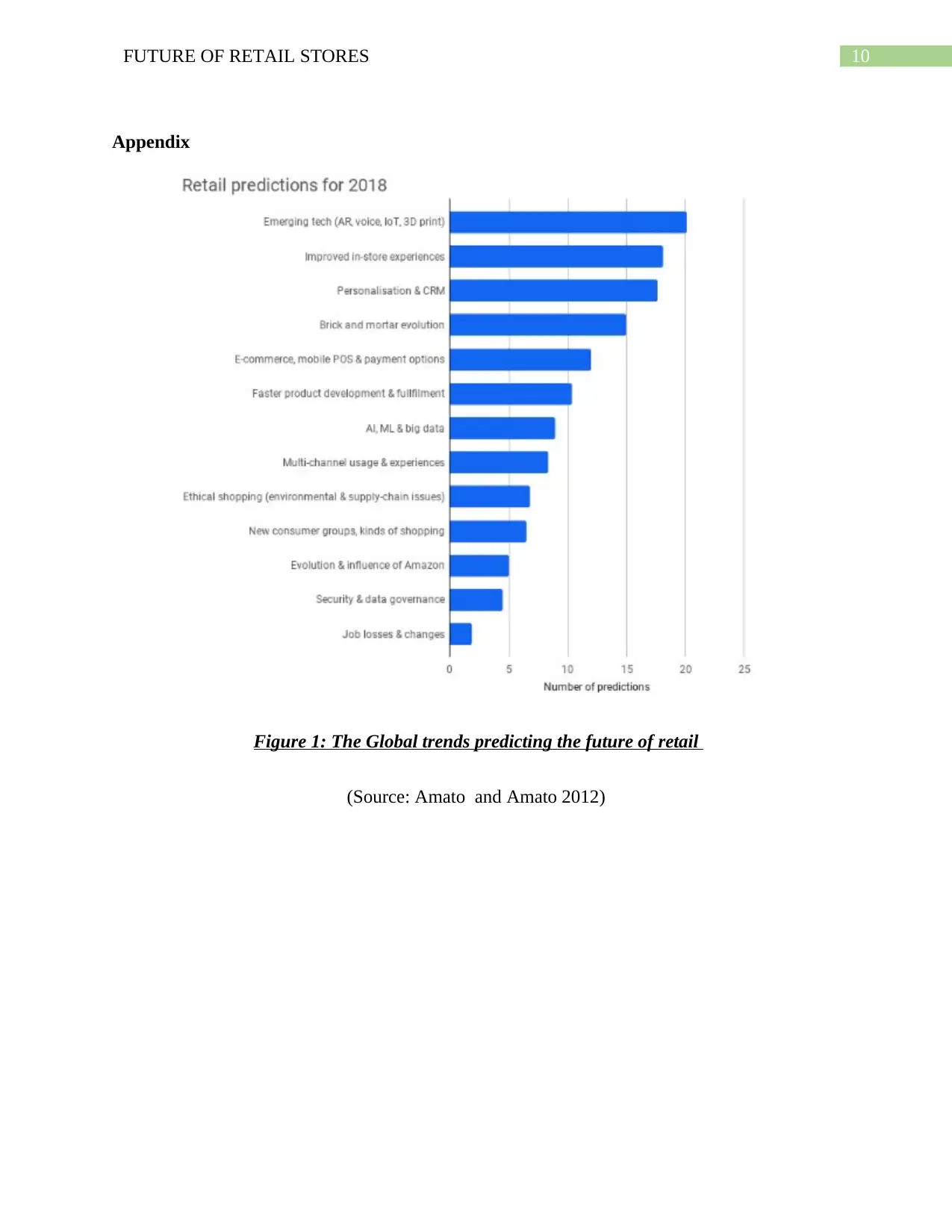
10FUTURE OF RETAIL STORES
Appendix
Figure 1: The Global trends predicting the future of retail
(Source: Amato and Amato 2012)
Appendix
Figure 1: The Global trends predicting the future of retail
(Source: Amato and Amato 2012)
1 out of 11
Related Documents
Your All-in-One AI-Powered Toolkit for Academic Success.
+13062052269
info@desklib.com
Available 24*7 on WhatsApp / Email
![[object Object]](/_next/static/media/star-bottom.7253800d.svg)
Unlock your academic potential
Copyright © 2020–2025 A2Z Services. All Rights Reserved. Developed and managed by ZUCOL.




